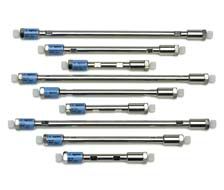ZORBAX RRHD Columns
Agilent Product Profile

Agilent is expanding its family of Rapid Resolution High Definition (RRHD) columns with four new phases, including two new C18 stationary phases. Now, there are four C18 phases to work with, so you have more selectivity flexibility in your method development. Furthermore, ZORBAX RRHD Columns help you take your UHPLC analysis further, by providing stability to 1200 bar.
The ZORBAX Eclipse Plus C18 phase features a double endcapped process and unique bonding that delivers exceptional peak shapes across a broad range of analytes. This makes it an exceptional column for method development. Many users of UHPLC are working with analyses that require the highest level of sensitivity and resolution. Alternate C18 phases, such as Extend C18 and Eclipse XDB C18 are desirable because of the additional selectivity refinements they allow.
See the difference ZORBAX RRHD columns can make in your UHPLC Analysis. Go to www.agilent.com/chem/C18choices to download an application note that provides more details about the difference in selectivities.
Jason Link, Product Manager, Jason_Link@agilent.com
Polysorbate Quantification and Degradation Analysis via LC and Charged Aerosol Detection
April 9th 2025Scientists from ThermoFisher Scientific published a review article in the Journal of Chromatography A that provided an overview of HPLC analysis using charged aerosol detection can help with polysorbate quantification.
Analyzing Vitamin K1 Levels in Vegetables Eaten by Warfarin Patients Using HPLC UV–vis
April 9th 2025Research conducted by the Universitas Padjadjaran (Sumedang, Indonesia) focused on the measurement of vitamin K1 in various vegetables (specifically lettuce, cabbage, napa cabbage, and spinach) that were ingested by patients using warfarin. High performance liquid chromatography (HPLC) equipped with an ultraviolet detector set at 245 nm was used as the analytical technique.
Removing Double-Stranded RNA Impurities Using Chromatography
April 8th 2025Researchers from Agency for Science, Technology and Research in Singapore recently published a review article exploring how chromatography can be used to remove double-stranded RNA impurities during mRNA therapeutics production.





